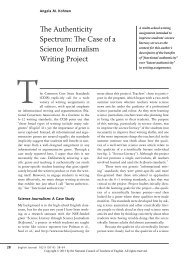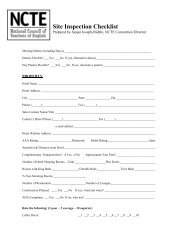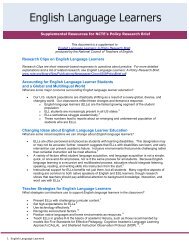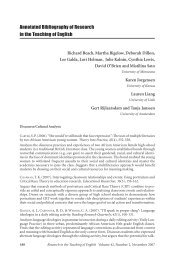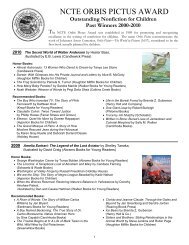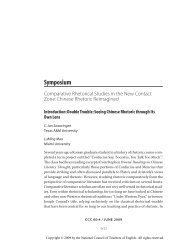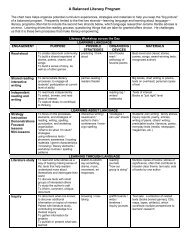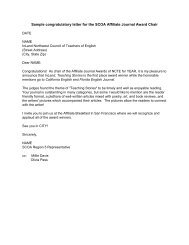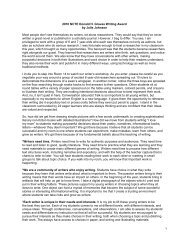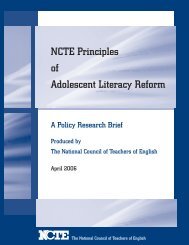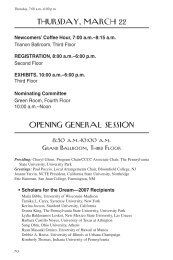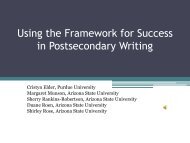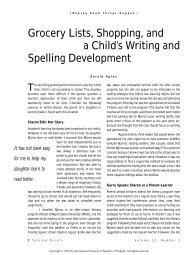Annotated Bibliography of Research in the Teaching of English
Annotated Bibliography of Research in the Teaching of English
Annotated Bibliography of Research in the Teaching of English
- No tags were found...
Create successful ePaper yourself
Turn your PDF publications into a flip-book with our unique Google optimized e-Paper software.
<strong>Annotated</strong> <strong>Bibliography</strong> 223MCCOACH, D. B., O’CONNELL, A. A., REIS, S. M., & LEVITT, H. A. (2006).Grow<strong>in</strong>g readers: A hierarchicall<strong>in</strong>ear model <strong>of</strong> children’s read<strong>in</strong>g growth dur<strong>in</strong>g <strong>the</strong> first 2 years <strong>of</strong> school. Journal <strong>of</strong>Educational Psychology, 98(1), 14-28.Exam<strong>in</strong>es longitud<strong>in</strong>al data collected at four po<strong>in</strong>ts <strong>in</strong> time across <strong>the</strong> k<strong>in</strong>dergarten and firstgradeyears as part <strong>of</strong> a large national study <strong>of</strong> more than 8,000 students. Attempts to understand<strong>the</strong> relative importance <strong>of</strong> various <strong>in</strong>dividual and school-level factors on read<strong>in</strong>g achievementat <strong>the</strong> end <strong>of</strong> 1st grade. Uses a three-level (time-student-growth) model to characterizestudents’ growth dur<strong>in</strong>g <strong>the</strong> first two years <strong>of</strong> school. F<strong>in</strong>ds that student-level variables such associoeconomic status (SES), race, and mo<strong>the</strong>r’s age at her first birth were best able to expla<strong>in</strong>differences <strong>in</strong> <strong>in</strong>itial status at k<strong>in</strong>dergarten entry. SES also predicted summer read<strong>in</strong>g growth.Suggests that <strong>the</strong> achievement gap is <strong>in</strong> major part due to differences <strong>in</strong> read<strong>in</strong>g skills at k<strong>in</strong>dergartenentry, comb<strong>in</strong>ed with <strong>the</strong> decl<strong>in</strong>e <strong>of</strong> read<strong>in</strong>g skills dur<strong>in</strong>g non-<strong>in</strong>structional periods suchas summer.RASINSKI, T. V., PADAK, N. D., MCKEON, C. A., WILFONG, L. G., FRIEDAUER, J. A., & HEIM, P. (2005). Isread<strong>in</strong>g fluency a key for successful high school read<strong>in</strong>g? Journal <strong>of</strong> Adolescent & Adult Literacy,49(1), 22-27.Explores read<strong>in</strong>g fluency as a contributor to read<strong>in</strong>g pr<strong>of</strong>iciency <strong>of</strong> 9th grade students. Assessedread<strong>in</strong>g fluency development among 9th graders and found a moderately strong correlationbetween fluency and overall read<strong>in</strong>g pr<strong>of</strong>iciency as measured by a standardized achievementtest. F<strong>in</strong>d<strong>in</strong>gs suggest that read<strong>in</strong>g fluency is a significant variable <strong>in</strong> secondary students’ read<strong>in</strong>gand overall academic development. Calls for more research <strong>in</strong>to <strong>the</strong> role <strong>of</strong> read<strong>in</strong>g fluencyamong older students, especially those experienc<strong>in</strong>g difficulty <strong>in</strong> achiev<strong>in</strong>g high levels <strong>of</strong> literacy.WILLIAMS, J. P., HALL, K. M., LAUER, K. D., STAFFORD, K. B., DESISTO, L. A., & DECANI, J. S. (2005).Expository text comprehension <strong>in</strong> <strong>the</strong> primary grade classroom. Journal <strong>of</strong> Educational Psychology,97(4), 538-550.Investigates <strong>the</strong> effectiveness <strong>of</strong> an <strong>in</strong>structional program designed to teach 2nd-grade childrenhow to comprehend compare-contrast expository text. Demographically similar 7–8-year-oldsparticipat<strong>in</strong>g <strong>in</strong> this study dur<strong>in</strong>g <strong>the</strong> 15 sessions were randomly assigned by classrooms <strong>in</strong>three schools to <strong>the</strong> follow<strong>in</strong>g conditions: text structure, content only, and no <strong>in</strong>struction. F<strong>in</strong>dsthat <strong>the</strong> text structure participants learned content and are able to demonstrate transfer <strong>of</strong> what<strong>the</strong>y learned to content beyond that used <strong>in</strong> <strong>in</strong>struction. Suggests that content area <strong>in</strong>structionhas optimal impact when it addresses both text structure and text content.WOLFE, M. B. W., & GOLDMAN, S. R. (2005). Relations between adolescents’ text process<strong>in</strong>g andreason<strong>in</strong>g. Cognition and Instruction, 23(4), 467-502.Exam<strong>in</strong>es <strong>the</strong> process<strong>in</strong>g strategies <strong>of</strong> 11- to 13-year-old students <strong>in</strong> mak<strong>in</strong>g sense <strong>of</strong> two conflict<strong>in</strong>gaccounts <strong>of</strong> a historical event. Exam<strong>in</strong>es <strong>the</strong> relation between students’ strategies dur<strong>in</strong>gprocess<strong>in</strong>g (us<strong>in</strong>g a th<strong>in</strong>k-aloud methodology) and <strong>the</strong> complexity <strong>of</strong> <strong>the</strong>ir subsequent reason<strong>in</strong>gabout <strong>the</strong> historical event. F<strong>in</strong>ds a positive relation between process<strong>in</strong>g and reason<strong>in</strong>g. Studentswho made more effort to establish connections with<strong>in</strong> and across texts, and expla<strong>in</strong>ed <strong>the</strong>connections dur<strong>in</strong>g process<strong>in</strong>g, produced more complex explanations after read<strong>in</strong>g.YOPP, R. H., & YOPP, H. K. (2006). Informational texts as read-alouds at school and home. Journal<strong>of</strong> Literacy <strong>Research</strong>, 38(1), 37-51.Describes two studies that document children’s exposure to, and experiences with, <strong>in</strong>formationtext as read-alouds <strong>in</strong> preschool (Study 1) and home (Study 2) contexts. Study 1 ga<strong>the</strong>red <strong>in</strong>formationfrom preschool through 3rd grade teachers about read-aloud frequency and titles <strong>of</strong>selections. The o<strong>the</strong>r study (Study 2) explored <strong>the</strong> types <strong>of</strong> books read aloud by parents ando<strong>the</strong>r family members to one class <strong>of</strong> k<strong>in</strong>dergarten students dur<strong>in</strong>g a seven-month time period



